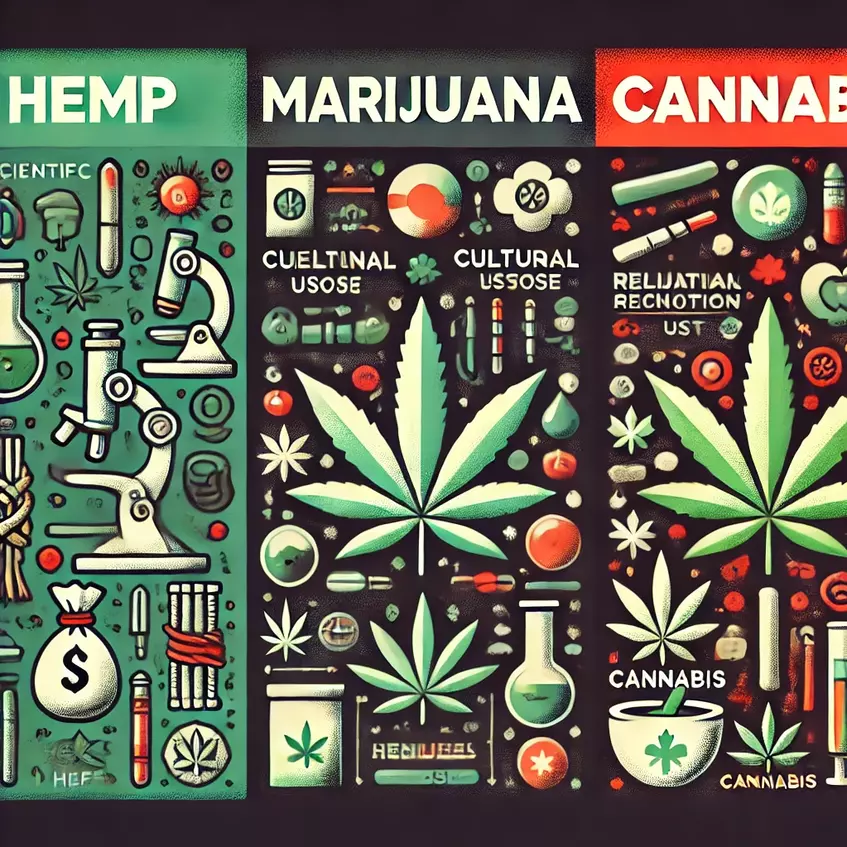When it comes to green plants, many people are confused by the variety of terms — hemp, cannabis, marijuana. But before diving into this confusion, it’s worth recalling one question that many have also pondered: so, is a tomato a vegetable or a berry? Some will say it’s a berry, while others desperately insist it’s a vegetable, since what else do we chop into salads? The story with hemp, cannabis, and marijuana is the same: even botanists, lawyers, and pharmacists argue about what is what. Let’s sort it out!
In Brief
The differences between the terms "hemp," "marijuana," and "cannabis" are more related to their usage and context than to the plant itself. Here are the main definitions:
Cannabis: This is the scientific name for the genus of plants Cannabis, which includes three main varieties — Cannabis sativa, Cannabis indica, and Cannabis ruderalis. This term is often used in official and scientific contexts, including medical research, legislation, and industrial production.
Hemp: Typically refers to cannabis strains grown for industrial purposes, such as the production of fabrics, ropes, paper, and building materials. Hemp contains minimal levels of THC (tetrahydrocannabinol), the psychoactive component that causes a "high." Usually, in industrial strains, the THC level does not exceed 0.3%, making hemp unsuitable for recreational use.
Marijuana: A term that refers to psychoactive strains of cannabis that contain a higher level of THC and are used for recreational and medical purposes. This term is widely used in media and legislation, especially in the U.S., where it has become popular due to cultural context.

From What Perspectives Can We View the Differences?
Depending on the context in which you are interested in the difference between hemp and marijuana, there are several viewpoints on this issue. Each of these perspectives will help understand why these terms are not synonymous, despite their common origin. So let’s look at these terms from different angles:
- Botanical Perspective
- Chemical Perspective
- Pharmacological Perspective
- Legal Perspective
- Economic Perspective
- Cultural Perspective
- Agricultural Perspective
- Ecological Perspective
Difference from a Botanical Perspective
Genus and species: All three terms refer to plants of the genus Cannabis. This genus includes several species, such as Cannabis sativa, Cannabis indica, and Cannabis ruderalis.
Morphology and cultivation characteristics: Hemp is generally tall and slender with strong fibers, while marijuana is characterized by bushier, shorter plants with dense flowers. These morphological differences also reflect their intended use and application.
Difference from a Chemical Perspective
THC and CBD content: One of the key factors that differentiate hemp from marijuana is the level of the psychoactive substance THC. Marijuana contains a high level of THC, which produces psychoactive effects. Hemp, on the other hand, has an extremely low level of THC (less than 0.3%) and a high level of CBD, making it non-psychoactive.
Cannabinoid and terpene profiles: Hemp and marijuana also differ in their chemical compounds, such as terpenes and secondary cannabinoids, which affect the aroma and medicinal properties of the plant.
Pharmacological Perspective
Effects on the body: Marijuana exerts psychoactive effects due to its high THC content, which activates receptors in the brain and induces euphoric states, relaxation, or altered perception. Hemp with high CBD content acts more as an anti-inflammatory and relaxing agent without affecting the psyche.
Medical applications: High-THC products are used to treat symptoms of chronic pain, depression, and other conditions requiring psychoactive effects. High-CBD hemp is sought after for alleviating inflammation, seizures, and treating epilepsy, where psychoactive effects are not needed.
Legal Perspective
Regulation and permissible standards: In most countries, marijuana and hemp are regulated differently. Hemp with low THC levels is legalized for industrial purposes in several countries and states, while marijuana with high THC levels is usually subject to strict control or prohibition.
Licensing and control: The requirements for growing low-THC hemp are generally less stringent, while for marijuana, due to its psychoactive properties, special licenses and compliance with strict control measures are necessary.
Economic and Industrial Perspective
Industrial use of hemp: Hemp with high fiber content is used to make fabrics, paper, cosmetics, and even bioplastics. This versatile plant has become particularly popular in industry due to its unique characteristics.
Recreational and medical use of marijuana: The demand for marijuana for medical and recreational purposes is growing, making it valuable from an economic standpoint, but with a limited market due to legal restrictions.
Cultural and Social Perspective
Historical use: Hemp and marijuana have different cultural histories. Hemp has been used in crafts for centuries, while marijuana has traditionally been consumed for ritualistic and medical purposes in some cultures.
Social perception: In several countries, stereotypes have developed around marijuana use, while hemp is associated with industrial and beneficial products. This perception also influences legal status and societal attitudes.
Agricultural Perspective
Methods and goals of cultivation: Hemp and marijuana require different cultivation conditions. Hemp can be grown on a large scale in open fields with minimal care, while marijuana often grows in greenhouses, where THC levels and other parameters are strictly monitored.
Selection and genetics: Hemp has been bred into varieties that are best suited for industrial use (fiber, oil). Marijuana also has many strains with high THC concentrations but requires special conditions.
Ecological and Ethical Perspective
Environmental impact: Hemp is an environmentally sustainable plant, as it requires less water and chemicals compared to other crops and helps restore soil.
Ethical perception: Since marijuana still evokes mixed opinions, its use for medical and recreational purposes has both supporters and opponents. Hemp, on the other hand, is perceived as an eco-friendly and beneficial plant, making its acceptance in society more positive.
Conclusion
Now that we have gone through all these aspects, the difference between marijuana and hemp becomes clear. If you ever get confused again, just remember that you found this information in the blog of the store Sexy-Seeds.com, which sells marijuana seeds. By understanding the meaning of each term, it’s easy to avoid misunderstandings, whether in industry, science, or everyday life.
Share your thoughts in the comments! Why do you think it’s important to know the difference between marijuana and hemp, and which term do you use more often?
